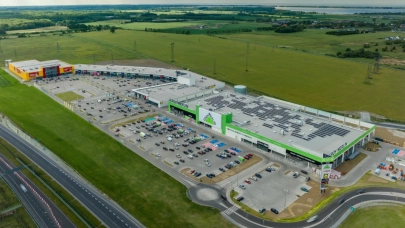
Close to 130,000 sq m was delivered to the market across all retail formats in Q4 2020, bringing last year’s total new supply to more than 340,000 sq m. Despite pandemic-related restrictions and successive lockdowns (7-28 November and from 28 December onwards), the fourth quarter witnessed 11 new retail completions and an outlet centre extension. Newly built schemes were sized under 20,000 sq m, and nearly half of the Q4 2020 new supply was delivered in cities below 50,000 inhabitants. Cushman & Wakefield summarizes current situation on Polish retail market.
2020 also saw a record-breaking square meterage come off the market. It amounted to close to 200,000 sqm of retail space following the closure of nine first-generation shopping centres (four Auchan and five Tesco schemes) and the Sukcesja shopping centre in Łódź.
Retail parks sized between 5,000-10,000 sqm account for more than 30% of retail stock under construction
Approximately 380,000 sqm of retail space is currently under construction and scheduled for delivery in 2021. A substantial proportion of the development pipeline (over 30%) comprises small-scale retail parks sized under 10,000 sqm.
“By providing a quick and convenient shopping experience, retail parks are ideally aligned with today’s consumer needs. This format has gathered momentum in Poland in recent years and its appeal has grown in particular during the pandemic. Minimum communal space, convenient car parks and separate entrances to each retail unit are both very attractive to customers and provide a significantly higher level of safety,” says Małgorzata Dziubińska, Associate Director, Consulting & Research, Cushman & Wakefield.
Additionally, small and medium-sized retail schemes demonstrated more resilience to the pandemic’s consequences in comparison with large and very large shopping centres. They reported significantly smaller footfall and turnover decreases, and were able to make up for losses more quickly.
Financing institutions have a key role to play in negotiations between tenants and landlords
“Successive periods of retail restrictions and unclear and inconsistent rules regarding which categories of tenants are permitted to open are not making for easy rental negotiations between tenants and landlords. Therefore, banks that frequently play a major role in financing both landlords and tenants are instrumental in such negotiations,” says Beata Kokeli, Head of Retail Agency, Cushman & Wakefield.
It remains to be seen in the coming months whether the current situation will have a lasting impact on retail rents. While temporary rent discounts average 20%, tenants also demand financial contributions and turnover-based rents. Landlords will consent to such conditions most often in exchange for a lease extension for more than a year.
The current pandemic has been a catalyst for change on the retail market and accelerated restructuring or closure decisions by many retailers. International brands that have left or will soon withdraw from Poland include Camaieu, Promod, Sportisimo, Salamander, and Stefanel. Meanwhile, fourteen brands opened their first Polish stores last year, including Primark, American Urban Outfitters, American Vintage, Giorgio Armani Beauty, Falconeri, Mere, and Mömax.
Average shopping centre footfall in the last week before the December lockdown reached 78% of last year’s level
According to PRCH data, shopping centre footfall was rising steadily after the first wave of coronavirus infections in spring, reaching as much as 90% of the previous year’s level in the last week of August 2020. Following the increase in infections last October, the shopping centre and retail park footfall fell to approximately 60%, but moved up to around 70-78% of the previous year’s level after the second November lockdown. Footfall in small and medium-sized retail schemes was several percent higher than in large and very large schemes. Customers favoured shopping centres located close to where they live, avoided crowded facilities and minimized in-store dwell times.
Cumulative turnover for January-November 2020 down across all product categories
PRCH data shows that October 2020 retail sales were down by 21.4% year-on-year in large shopping centres (sized 40,000-plus sqm) and by 18.5% in smaller retail schemes (below 40,000 sqm). The cumulative fall for January-November 2020 amounted to 28.9% for large and very large shopping centres, and to 24.7% for small and medium-sized centres compared to the previous year. The steepest cumulative year-on-year falls in turnover for January-November 2020 were reported in services (-66.2%) and entertainment (-60.1%). Food & Beverage tenants suffered a 33% loss of turnover while fashion retailers witnessed a 32.4% loss. Falls were more limited in health and beauty (-21.5%) and food (-7.8%). Despite very good results in May-October, homeware retailers also reported an 8.0% decrease in turnover in January-November 2020 compared to the same period a year earlier.
Pandemic accelerates the digital transformation of retail
“The online retail penetration rate (share of total retail sales) stood in Poland at around 5-6% before the pandemic. As a result of successive retail restrictions and many weeks of a total ban on brick-and-mortar retailing, e-commerce was the only distribution channel available to many retailers. Poland saw its online retail penetration rate reach all-time highs of 11.9% in April and 11.4% in November 2020. The pandemic has, however, demonstrated that brick-and-mortar retailing looks set to continue as many Polish people remain attached to traditional shopping, best illustrated by much weaker online sales following the lifting of lockdowns and easing of restrictions imposed on shopping centres,” says Małgorzata Dziubińska.



